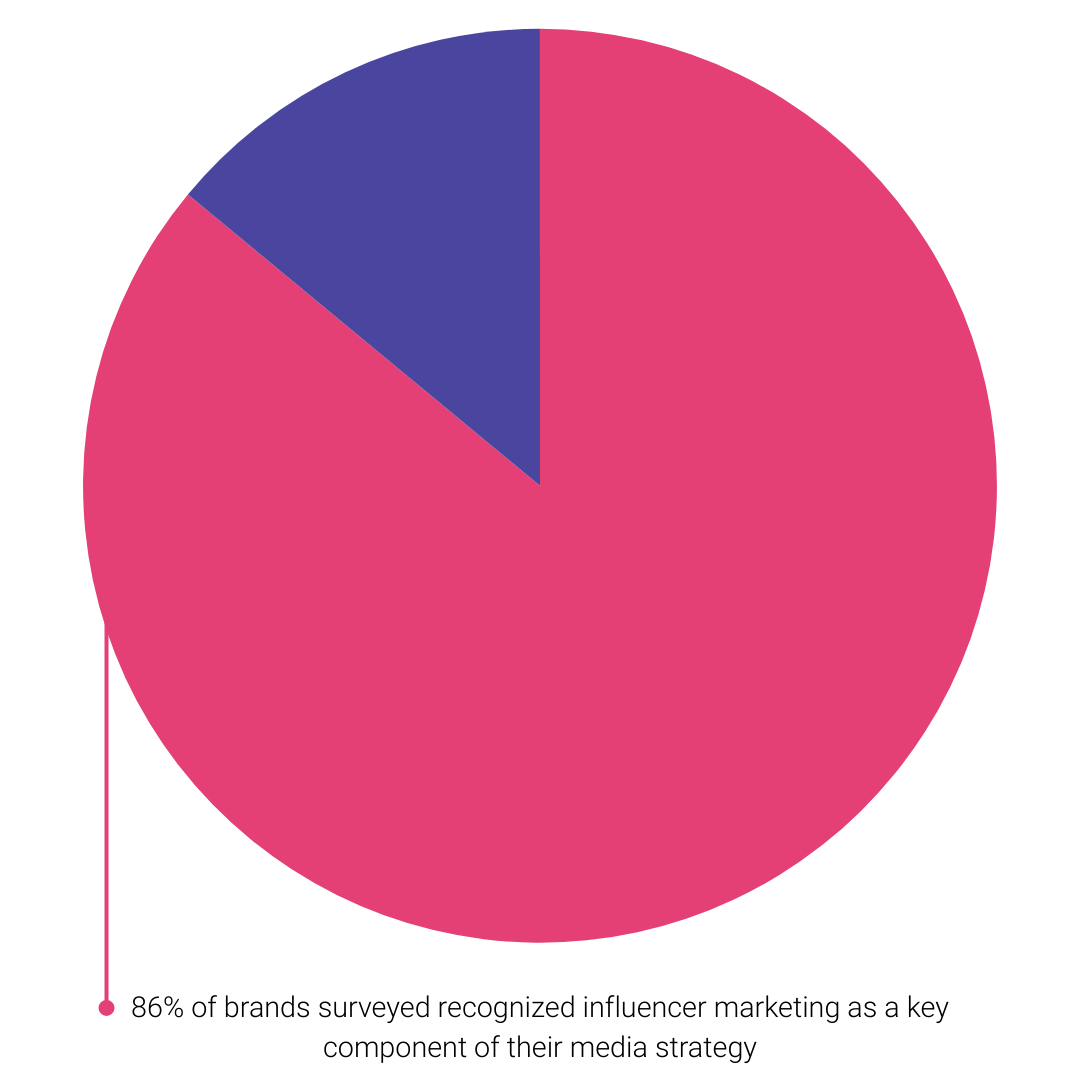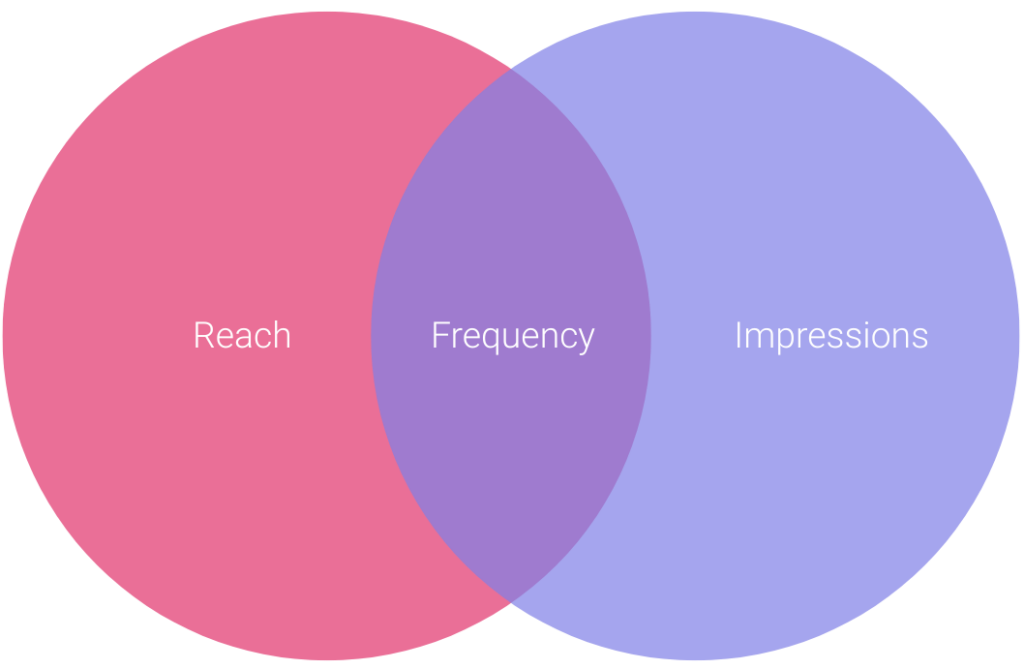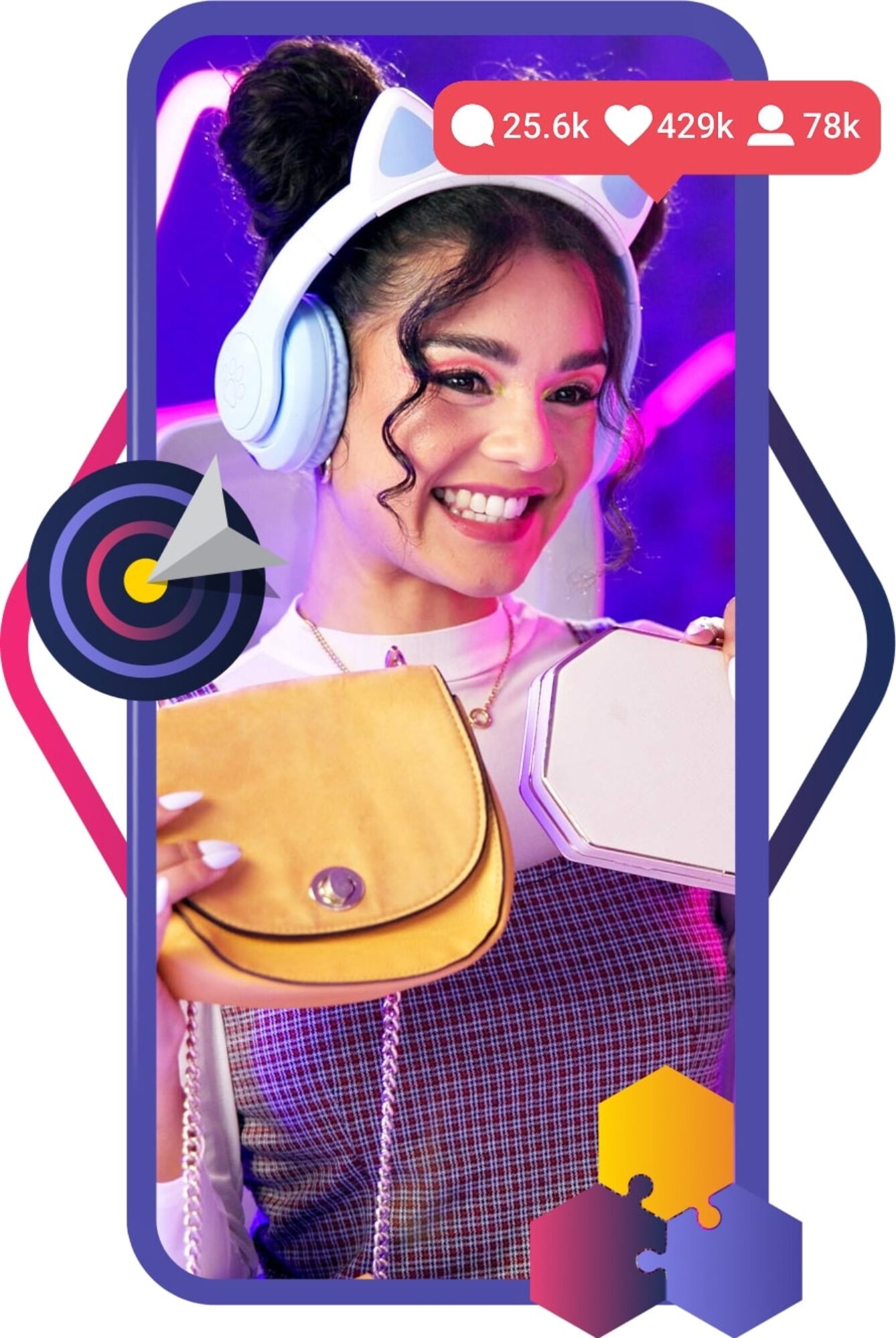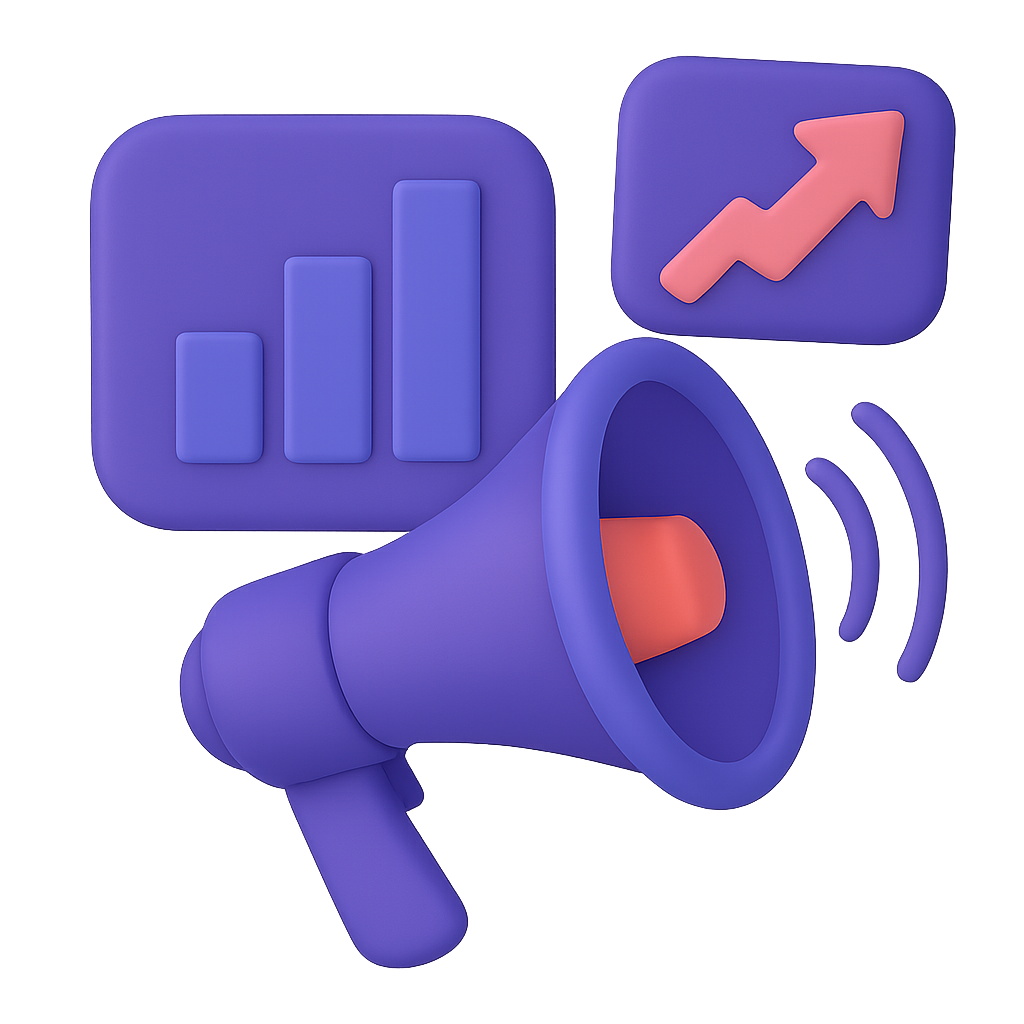15 Influencer Marketing KPIs to Track in 2025

This year, influencer marketing will become more data-driven than ever. In 2024, 86% of brands recognized influencer marketing as a key component of their media strategy. Its growing footprint speaks to the success brands are seeing by partnering with influencers. Influencers are uniquely positioned to become your advocate within their communities. Gone are the early days when marketers used hashtag stuffing to go viral. Massive reach is no longer the sole influencer marketing KPI. The growing demand for influencer marketing highlights that it can drive real-world outcomes like purchases and shift brand perceptions. Influencer marketing is a force to be reckoned with. If you know which influencer marketing KPIs to track, you can build better campaigns and measure results that will help you make better strategies in the future.
In this article, we’ll showcase our favorite influencer marketing KPIs and even share tips for driving stronger engagement. To elevate your influencer marketing strategy, you need a clear measurement plan, well-defined influencer marketing KPIs, and mastery of conversion tracking. This guide will show you how. Ready to dig in? Let’s get started.
Ready to accelerate your influencer marketing KPIs? Partner with us! Connect with our experts to see how we can drive measurable results together.
Table of contents
- What are Influencer Marketing KPIs?
- 15 Key Influencer Marketing KPIs To Track in 2025
- How To Track and Measure Influencer Marketing KPIs
- Key Considerations for Choosing the Right KPIs in Influencer Marketing
- Best Practices For Tracking KPI
- Partner with AdParlor for Influencer Marketing Success
- FAQs
- Final Thoughts
What are Influencer Marketing KPIs?
Influencer marketing KPIs (i.e. Key Performance Indicators) are measurable metrics that marketers can use to evaluate the effectiveness of their influencer marketing strategies – including reach, engagement, and conversion-based metrics. As influencers can add value to all parts of the marketing funnel, it’s important to pick influencer marketing KPIs that align with your specific goals for each campaign.
As influencer marketing has gained traction, businesses are increasingly leveraging it as a key growth driver. Your influencer marketing KPIs should align with and support your marketing goals. Some marketers choose to add paid amplification to increase their reach. This additional investment makes it possible to optimize toward these goals in a way organic cannot, but the increased investment also comes with increased scrutiny.

Measuring Campaign Performance
Influencer marketing isn’t just about reaching audiences—it’s about measurable impact, strategic execution, and delivering results faster than ever. With digital footprints left at every step, brands now expect the receipts. This is where influencer marketing KPIs come in.
Influencer marketing KPIs are the compass guiding your influencer marketing efforts. They offer a quick snapshot of campaign performance, helping you pinpoint what’s working and identify areas for optimization. Influencer marketing KPIs are even more critical because they help measure the direct impact of influencers on your brand’s goals, ensuring that every partnership drives measurable results.
Digging into these influencer marketing KPIs empowers you to make informed decisions, refine your strategy, and optimize your influencer partnerships to take your performance to the next level.
ROI Tracking
Monitoring your influencer marketing KPIs helps you understand the return on investment. By comparing your total investment with the revenue generated, you can quickly identify which areas of your strategy are truly driving results. Influencer marketing takes ROI analysis a step further. By tracking voucher codes, affiliate links, and conversion data, you can pinpoint which influencers are moving the needle. If one influencer is driving the majority of your sales, reallocating your budget becomes an easy decision.
Identifying the Right Influencers
Influencers will be front and center this year for Unilever’s brands. The brand plans to invest half of its media dollars into influencer-led strategies. I can already smell the Axe Body Spray infiltrating my algorithm. So how do you find the right influencers anyway?
Understanding your influencer marketing KPIs will help you when it comes time to source influencers.
- If your goal is reach, you’ll need to ask yourself if your selected influencers have the scale ended to make an impact. If anything, the Will it be Banned saga surrounding TikTok has showcased the importance of diversification. Award brownie points to influencers that have nurtured audiences on at least two channels.
- If your influencer marketing KPI is focused on engagement, reviewing engagement rates is crucial to building a strong strategy and ensuring meaningful interactions with your audience.
Enhancing Audience Engagement
- Look for influencers with active, leaned-in communities with strong engagement rates. This is going to be particularly important for brands with engagement influencer marketing KPIs. A large following but minimal engagement could mean you’re dealing with a bunch of ghost followers. Yes, that Insta account could be haunted. 👻
- On the flip side, a small following with ludicrously high engagement isn’t great either. If it seems suspicious, it probably is. Bots can drum up spammy comments like 🔥🔥🔥 or “Love This!”. You deserve real eyeballs. Our advice – run!
Optimizing Future Campaigns
The goal of any killer marketing campaign? Keep leveling up! Take those hard-earned lessons from past campaigns to come back bigger and stronger. Renew contracts with your A-listers. Take those comments to heart. The next big idea could be right in front of you.
15 Key Influencer Marketing KPIs To Track in 2025
To ensure your influencer campaigns drive real, trackable results (not just fire emojis), here are 15 influencer marketing KPIs every marketer should add to their repertoire.
Reach & Impressions
Reach highlights how many unique people were exposed to your influencer marketing campaign, while impressions quantify how many times your campaign was seen overall.

These influencer marketing KPIs may feel like Marketing 101, but paired with costs, they can unlock some serious insights into your campaign’s efficiency.
Hashtag Performance & Virality
Hashtags were once the golden ticket to social media visibility. Campaigns like #ShareACoke turned a simple tagline into a global movement. By replacing its iconic logo with popular names on bottles, Coca-Cola encouraged consumers not just to buy a Coke but to hunt for bottles with names of people who mattered to them. The campaign went viral as people eagerly posted photos of the names they found.
In 2025, hashtags continue to play a role in driving engagement, but the approach has evolved. While TikTok still thrives on hashtags, other platforms, like Instagram, have adjusted their focus. Instagram’s leadership has confirmed that hashtags no longer significantly boost reach. Late last year, they removed the ability to follow hashtags. It’s important to use them thoughtfully, as overstuffing can dilute their effectiveness and potentially impact engagement
For channel-specific hashtag best practices and even more hashtag history, check out this recent article.
Engagement Quality Score
This is where engagement quality comes into play. Organic algorithms use content engagement metrics to determine what content to serve. But let’s be honest… not all engagements are created equal. Sure, telling your client you got 1,000 likes on a post feels massive, but how many of those likes were meaningful? The real gold is in the comments – and, like gold, you have to dig for it. Are your comments coming from genuinely interested people? Are they engaging in a way that suggests future actions? If so, congratulations! Your strategy is successfully moving a potential customer down the funnel.
Engagement Rate
Marketers track engagement rate to gauge how well content resonates with their audience. Knowing what works is the key to building an evergreen influencer strategy. This influencer marketing KPI shows what percent of your audience engaged – and that’s what matters.
At AdParlor, we care about actions – such as likes, comments, shares, clicks, and saves when evaluating performance. Longer view times are nice, but engagements mean they care. So how can you spark more engagement on your influencer campaigns? It starts with your creative brief. Partner with influencers who excite their communities and feel like a natural extension of your brand. Why?
- When content feels authentic, people engage.
- Good community builders ask questions and keep the conversation going.
- Timing matters. The real pros know to post when visibility and engagement are highest.
Organic engagement rates vary by influencer size. Smaller tiers, like nanos and micro-influencers, often showcase higher engagement rates. And honestly, this makes sense.
Think about how your engagement differs on group text messages. Where are you most engaged? The four-person chat you have going with your besties? Or the 20-person family chat about Thanksgiving.
Cost per Engagement (CPE)
Cost per engagement shows how much you paid per engagement. This influencer marketing KPI is an important efficiency metric. Similar to CPM and CPR, cost per engagement identifies which influencers delivered the best value for your investment.
If you’re adding paid amplification to your tactics, marketers should prioritize boosting organic content that best resonates with your audience. How can you tell which posts to boost? Sort your posts by CPE. Posts with the lowest CPE could make great candidates to amplify your messaging to a broader audience.
Video Completion Rate (VCR)
This influencer marketing KPI shows how many people watched your video content from start to finish.
Video completion rates are a helpful gauge for video engagement, but creative length matters. A 6s clip will naturally have a higher VCR than a 30s spot. In the world of social media, anything longer than 5-6 seconds risks losing attention. Viewers may skip, scroll, or simply disengage. 🙀
But don’t panic, you can rally against short attention spans and ad format functionality. Here are some creative tips to help encourage longer view time.
- Be thumb-stopping. Attract their attention and avoid the dreaded scroll.
- Go native. Embrace trends and create content that feels natural to the platform. Influencer marketing is a great way for brands to tap into this.
- Don’t be afraid. Longer content can work if it’s engaging! Don’t let a vanity metric stifle your creativity. Give influencers the runway to connect with their communities in impactful ways.
Brand Mentions & Sentiment Analysis
We’ve established the importance of understanding which engagements carry more sway. Let’s take a step back and determine if these engagements are a good thing or not.
Tracking brand mentions and sentiment can be like having your own virtual focus group. It’s a way to monitor your brand’s online reputation. Positive mentions? Great! Negative mentions? Don’t panic. Use this as an opportunity to rethink your strategy. Just remember: mentions are great, but sentiment? That’s the real tea.
Earned Media Value
In the end, what is all this goodwill worth? Earned media value can put this all into perspective. This influencer marketing KPI provides insight into the estimated value of your influencer marketing strategies. There is no standardized formula, and influencer marketing platforms often have proprietary EMV metrics. Long story short, it’s the media value of metrics that the platform or agency deems important. It can factor in the value of your engagement metrics, such as the value per like or comment. Some companies also factor in the value per impression.
EMV is a valuable influencer marketing KPI that helps estimate the ROI of your strategy. By comparing influencers head-to-head, you can identify who delivers the most value. This can help highlight who you should consider working with in the future.
Are all these influencer marketing KPIs starting to make your head spin? Marketing jargon can sometimes make you want to yell “Uncle!”. If you need help determining your influencer marketing KPIs, we’re here to help – let’s connect!
Click-Through Rate (CTR)
This influencer marketing KPI shows what percent of your impressions generated clicks.
A high CTR indicates that your audience finds the content relevant and engaging. Driving a ton of traffic to your brand’s site may feel good, but what are people doing once they get there?
- Track your bounce rates.
- Learn what audiences are more likely to engage with the site.
- Consider optimizing toward an upper-funnel event, such as view content. This can be beneficial in finding a more leaned-in audience.
Like CPM, many factors can impact your click-through rate.
- CTRs will drastically increase when marketers optimize toward mid- and lower-funnel tactics.
- Creative that resonates with your audience and has a strong CTA will drive stronger click engagement – often at a lower cost.
Conversion Rate (CVR)
This influencer marketing KPI shows what percent of your clicks generated conversions.
Influencer marketing strategies can be a full-funnel approach. Tracking conversions helps marketers prove the bottom-line impact of partnering with influencers. Here are some tips to improve your tracking.
- UTM parameters help attribute conversions in platforms like Google Analytics.
- Affiliate links and promo codes can track purchases back to individual influencers.
- Post-purchase surveys empower your customers to share how they learned about your product. Pura Vida found that 32% of net new customers came from TikTok.
Tracking your CVR influencer marketing KPI is not always very straightforward, especially where there are many sources of truth. What can you do? Diversify your tracking methods! Having more data points will help prove the value of influencer marketing.
Keep in mind that not all conversions will appear in Google Analytics. TikTok Shop purchases are only tracked within the TikTok platform. This is because those consumers never made it to the brand’s site.
If you’re secretly relieved that only TikTok knows about your shopping addiction, you’re not alone.
Customer Acquisition Cost (CAC)
Growing your business means you must reach and acquire net new customers. Tracking the cost to convert new customers (CAC) is a vital influencer marketing KPI for long-term brand growth. The challenge? How people discover new brands is rapidly evolving. Younger generations are more likely to discover new brands and products from user-generated content than previous generations. This makes influencer marketing strategies an essential part of your acquisition plan.
User acquisition reporting in Google Analytics is one effective way to track new customers. This report organizes first-time users by channel groups (such as organic or paid social). Why is this useful? This data can show how effectively your influencer marketing campaigns are driving new people to your site.
To reduce CAC, brands can…
- Consider incentivizing first-time customers through exclusive offers or discount codes. Partner with micro-influencers. This tier of influencers will typically offer you more targeted reach at a lower cost. For more information on influencer costs, we’ve shared the tea here.
- Long-term partnerships are a trend to watch in 2025. People can be hesitant to buy something new. Influencers can reduce the perceived risk by creating a consistent narrative and building trust. Over time, this helps keep your brand top-of-mind, making it easier to convert new users and reduce CAC.
Once you identify high-performing posts, repurpose those assets across your paid social media strategy to maximize your impact. By excluding existing customers from prospecting, you ensure your budget is fully dedicated to acquiring new customers
What’s even better tracking? “First-Time Purchaser” or “New User Signup” events can track acquisition more accurately.
Return on Ad Spend (ROAS)
If you divide your attributed revenue by your total ad costs, you get your ROAS. For example, if a campaign spends $50,000 and generates $100,000 in tracked revenue, your ROAS is $2. This means that for every $1 spent, the brand earned $2 in revenue.
This is an important influencer marketing KPI for lower funnel activations. While most lower-funnel tactics aim to optimize for conversion volume, it’s important to ensure your strategy aligns with your budget. Social media platforms typically recommend a minimum of 50 conversions per week per ad set to exit the learning phase. If reaching that threshold isn’t feasible, start by optimizing for a more accessible, mid-funnel objective instead.
Brands offering a wide range of product values should consider testing value optimization. This approach helps maximize revenue by targeting the most valuable customers.
Return on Investment (ROI)
If ROAS is the flashy, attention-grabbing sibling, ROI is the fiscally responsible one keeping an eye on the bigger picture. Return on Investment is very similar to ROAS – except it encompasses the total investment of your influencer marketing strategy. This includes things like:
- The media and influencer costs.
- The agency fees.
- The cost of the product you provide to influencers for promotion.
All these things start to add up very quickly. If you divide your attributed revenue by your total investment, you get your ROI.
For brick-and-mortar stores, you can also track ROI regarding foot traffic, an influencer marketing KPI that’s essential for understanding how marketing impacts physical store visits. Here are five ways you can do it.
Audience Growth & Follower Quality
We don’t need any more followers, said no one ever. Follower counts can be a slippery slope. On the one hand, having followers can up your street cred. On the other hand, having many followers and no engagement might lead you to ask yourself, “What am I even doing?”
Trust us, you don’t want followers who only hit “like” on your posts because their thumb accidentally brushed the screen. Like all things, value quality over quantity. Engaged, leaned-in followers can become ambassadors for your brand – both officially and unofficially.
Follower quality is also important when you pick the influencers you want to work with. That’s why engagement rates are closely reviewed during AdParlor’s vetting process to ensure you’re getting access to thriving communities, not bots.
Influencer Content Longevity
As an influencer marketing company, we know that nothing beats launch day. It’s the culmination of weeks of creative briefs, negotiations, revisions, and let’s face it – revisions of revisions. Launch day means we made it! But what happens next? Influencer content longevity tracking is how long an influencer’s posts continue to reach new audiences.
We recommend having influencers post more than once to maintain a more evergreen look and feel. On Instagram, this could mean producing content for different placements, such as reels and story content. Your platform selection can also have an impact on longevity. YouTube and Pinterest content lives on forever, just like Harry Potter movies – they’re always on somewhere.
Influencer marketing KPIs can also be scaled by including paid amplification. This allows marketers to put paid dollars behind their best content.
How To Track and Measure Influencer Marketing KPIs
Influencer marketing is the shiny new thing in the marketing world — and for good reason. Partnering with the right influencer can create buzz, drive engagement, and boost sales. While it’s easy to get caught up in the excitement, you need to prove that it’s delivering real business value. Without concrete results, it’s hard to get long-term buy-in from stakeholders — and even harder to justify budget increases. Here’s how to track influencer marketing KPIs to keep everyone on board.
Methods for Tracking KPIs
Tracking influencer marketing KPIs can range from easy to sophisticated.
- Manual Tracking. This involves consolidating data from all posts, website traffic, and sales reports. Manual tracking is low-cost but risky. One data entry mistake can throw off your results
- Analytics Tools. Platforms like Google Analytics and social media platform tracking is more automated. Attribution helps connect the dots between campaigns and results.
- Influencer Reports: Influencers provide post-campaign reports when other tools are not available. Collecting influencer reports is tedious, and that’s before you even analyze them.
While tracking your influencer marketing KPIs manually is, in fact, possible, why make it harder than it needs to be? These specialized companies can access additional tools, platforms, and relationships. Influencer marketing Agencies not only handle the heavy lifting; they also bring strategic insights to optimize future campaigns. Plus, they know how to tailor reporting needs so you can confidently present results to your stakeholders. That’s a win-win!
AI is the biggest buzzword right now, and for good reason. Influencer marketing platforms automate a lot of the manual grunt work. They streamline creator discovery, generate smart recommendations, keep tabs on brand safety, and more. By reducing the need for manual tracking, AI helps surface actionable insights faster. These platforms simply make influencer tracking more efficient.
Key Tools & Technologies for Tracking
Google Analytics
Google Analytics gives you a clear picture of how influencer tactics impact site engagement. Most importantly, they reveal whether it led to the ultimate trump card – sales! The kicker? UTM parameters must be set up correctly to enable proper tracking.
- Keep in mind that not all conversions will appear in Google Analytics. For instance, TikTok Shop purchases are only tracked within the TikTok platform. Why, you ask? Those consumers never made it to the brand’s website.
Social Media Insights
Yes, social media platforms have a ton of your influencer marketing KPIs in one place, but they offer so much more! You can see how different audiences are responding to your campaign. TikTok also has a sentiment tool built directly into the platform.
Affiliate Links
Affiliate links track influencer-driven clicks and sales but do not paint the entire picture. To track a sale, your consumer must click on the link and decide immediately to buy. If they come back later and purchase, you can kiss tracking that sale goodbye. Brands can partner with solutions – like SmartCommerce – to consolidate their affiliate link results in one place. SmartCommerce will even use modeling to help estimate the number of conversions based on your tracked conversions. This can help fill in the gaps when using conversion-focused influencer marketing KPIs.
Voucher Codes
Voucher codes can address some of the limitations that affiliate links present. These custom codes allow marketers to track a sale to an individual influencer – no matter what. This is great, especially if you’re reaching people who might need more time to decide.
Custom Pixels
Pixels track user behavior on your website and are essential for understanding lower-funnel impact. Not ready to optimize for sales? Add the pixel anyway! Trust us. The platform will learn what your customer looks like, whether you’re trying to sell a product or not. When you optimize toward conversion-based influencer marketing KPIs, you’ll have a head start.
Key Considerations for Choosing the Right KPIs in Influencer Marketing
I get it. Choosing the right influencer marketing KPIs can seem overwhelming. When in doubt, keep it simple. Choose influencer marketing KPIs that align closely with your goals. Here’s how to pick influencer marketing KPIs that drive real impact.
1. Understanding Your Marketing Objectives
Do your homework first. What are your overall marketing goals? Without a crystal-clear vision, you may end up with influencer marketing KPIs that do not make sense. Or worse, choose influence marketing KPIs that are not attainable. Are you trying to increase brand awareness, drive sales, or generate leads? Influencer marketing KPIs should change with every step of the customer journey. Success at each stage will look different.
- If you’re more awareness-focused, then sales-focused influencer marketing KPIs should not even be on your radar yet.
- If you’re prepared to ask for the sale, you might not care how long they watch the ad.
Setting clear, measurable objectives from the start ensures that the influencer marketing KPIs you choose are meaningful and actionable.
2. Aligning KPIs with Campaign Goals
To set yourself up for success, you need to align your influencer marketing KPIs with the goals of your campaign. This way, you can actively optimize towards your goals rather than just hoping for the best.
- Awareness Goals. Focus on reach and impressions. Engagement metrics can be a secondary influencer marketing KPI to see how people are responding.
- Consideration Goals. Focus on click-through rates. Some marketers consider video engagement a nice mid-funnel influencer marketing KPI as well. If someone chooses to watch your ad instead of skipping it, that’s a win in my book.
- Conversion Goals. Now is the time to bring in those heavy hitters. Influencer marketing KPIs like conversion rate, ROAS, and customer acquisition have finally entered the conversation.
Does this mean the other influencer marketing KPIs don’t matter? Of course not, but having your influencer marketing KPIs locked lets you know what to focus on. Your influencer marketing KPIs should impact the decisions you make from here on out.
3. Quantitative vs. Qualitative Metrics in Influencer Marketing
A balanced strategy includes both quantitative and qualitative influencer marketing KPIs. What’s the difference?
- Quantitive metrics involve numbers (i.e., quantities). We’re talking impressions, clicks, conversions, etc. These influencer marketing KPIs track direct outcomes.
- Qualitative metrics deal with words (i.e., qualities). This is where those more nuanced influencer marketing KPIs come into play – like brand sentiment. Analyzing comments and mentions gives you an idea of how consumers feel about your brand. Remember your hypothetical party? You can tell if your guests are having a good time based on what they’re saying. It works the same in the world of marketing.
A campaign that generates high engagement but negative sentiment might need a shift in messaging or influencer selection. Tracking both types of influencer marketing KPIs gives you a more holistic view of performance.
4. Tracking Engagement and Conversion Rates
Engagement and conversion rates are the influencer marketing KPIs you rely on to know if your campaign is thriving or if it needs a little tough love.
- Engagement rate indicates how well your content is resonating with your audience. Low engagement is your first sign that your creative strategy needs adjusting.
- Tracking conversions can be complex and messy, but it’s essential to measure real impact. UTM links, unique discount codes, and affiliate links help connect influencer activity to sales or leads. Have a high click-through rate but a low conversion rate? This could signal that something is causing friction during the shopping experience. Now is your chance to put on your consultant hat. I suggest you do some “practice” shopping. Yes, practice makes perfect.
Analyzing your influencer marketing KPIs allows you to refine your strategy and improve performance.
5. Evaluating Influencer Impact on Brand Awareness
Everyone has a story they can share about how an influencer–well–influenced them. #TikTokMadeMeBuyIt is still trending. Influencer marketing and social media have become the ultimate advertising power couple. Tracking improvements in qualitative influencer marketing KPIs can be more difficult.
- Brands with ample influencer investment can use brand lift studies to detect lift in key areas. Are you a little short on funds? Combining influencer-led creative with your BAU creative can also be impactful. Don’t believe me? Meta has a whole section dedicated to the impact of these partnership ads.
- Social listening is a game-changer for monitoring awareness – without the price tag. Tracking mentions, sentiment, and branded keywords before, during, and after lets you track changes over time. It’s powerful when you can see where you’ve been and exactly where you’re headed.
Best Practices For Tracking KPI
Tracking influencer marketing KPIs isn’t just about measuring success. It’s about transforming data into a strategy that drives growth. You’ll need a clear framework for setting, monitoring, and adjusting your influencer marketing KPIs. These best practices will turn your insights into action.
1. Set Clear Benchmarks
Before launching a campaign, establish realistic expectations. Look at historical results from past influencer marketing KPIs to set your baselines. And whatever you do, don’t overpromise. If your campaign is underperforming, have those uncomfortable conversations with your clients. Things don’t always go according to plan. Remember, marketing is a process. You have to crawl before you can walk, and every campaign is an opportunity to learn and improve for the next one.
2. Use the Right Tools
The tools you use to track your campaign performance are critical to getting accurate insights and tracking your influencer marketing KPIs. Prioritize analytics platforms that can provide you with real-time data. These tools allow you to make adjustments throughout your campaign. Delayed data means you may not be allocating your budget as wisely as possible. This can hurt your ROI in the long run.
Supplement your tracking strategy with custom tracking codes or affiliate links. While these aren’t as comprehensive, they can give you a good touch point on how your campaign is performing directionally.
3. Track KPIs Continuously
Tracking influencer marketing KPIs isn’t a one-and-done process. Monitor data throughout the campaign to spot trends and make adjustments. If engagement is strong but conversions are low, you may need to tweak the call to action or targeting. Teams that make these real-time adjustments show they’re invested in the success of the campaign.
4. Engage with the Audience
Don’t just track the numbers; pay attention to the conversation. Comments from the influencer’s audience offer valuable insights. Are people excited about the product? Are they asking questions or raising concerns? Honestly, your next big idea is probably hidden away in those comments, waiting to be discovered. Your audience will notice when you listen.
By setting clear benchmarks, using the right tools, tracking continuously, and engaging with the audience, you can create a powerful feedback loop that drives better results and long-term success.
Partner with AdParlor for Influencer Marketing Success
Ready to work together? Our influencer marketing services are designed to help you achieve measurable results. We begin by crafting a tailored strategy that aligns with your brand’s goals, setting clear influencer marketing KPIs to guide our approach and ensure success.
From there, we identify and vet influencers who resonate with your target audience, ensuring that every partnership is built on authenticity and strong engagement potential. As we manage these partnerships, we track progress against our influencer marketing KPIs, adjusting strategies as needed to stay on course.
Additionally, we amplify your influencer content to maximize reach, using insights from your influencer marketing KPIs to fine-tune the campaign for optimal performance.
With our comprehensive approach, we ensure that every step is driven by our influencer marketing KPIs, giving you confidence in the results we deliver.
Strategy & Planning
Influencer Selection & Vetting
Partnership Management
Content Amplification





At AdParlor, we know that influencer marketing can take your brand to the next level, but it needs a solid strategy to truly drive results. That’s where we come in. We work with businesses to craft influencer campaigns that are not only aligned with your goals but also backed by solid data. From pinpointing the right influencers to tracking performance with influencer marketing KPIs, we make sure every campaign is dialed in for success. Whether it’s planning the strategy, managing partnerships, or amplifying content, we bring the expertise to help you get the most out of your influencer marketing efforts — all while giving you the insights you need to make smarter, more informed decisions along the way.
When you partner with AdParlor, your success is our success. Take Rocky Mountain Chocolate Factory for example. Last year, they wanted to go big for National Caramel Apple Day. AdParlor sourced all its influencers and devised a strategic plan to raise awareness around participating stores. The campaign fueled a 26% YoY increase in caramel apple sales that day. The proof is in the pudding (or caramel in this case), working with influencer marketing experts is a recipe for success.
FAQs
Influencer marketing performance is typically measured by:
Engagement Influencer Marketing KPIs: Likes, comments, shares, and mentions on influencer posts help gauge how well the audience responds to the content.
Reach and Impressions: These influencer marketing KPIs track how many people saw the content and how far it spread.
Conversion Influencer Marketing KPIs: Tracking actions like website visits, purchases, and sign-ups resulting from the campaign. This can be measured using pixels, UTM links, affiliate links, or discount codes.
Sentiment Analysis: Assessing the audience’s tone and reactions to the campaign through comments and feedback, helping to gauge brand perception.
Mission: What is the objective of the campaign? This could range from brand awareness to conversions or product launches.
Message: What key message do you want to communicate through the influencer’s content? The message should align with the brand’s voice and goals.
Media: What platforms and channels will the influencers use to reach the target audience?
Measurement: What influencer marketing KPIs will you use to measure the success?
Yes, micro-influencers can often achieve better influencer marketing KPIs results than macro-influencers, especially in terms of engagement and cost-effectiveness. Here’s why:
Stronger Niche Targeting: Micro-influencers often specialize in specific niches, allowing brands to reach highly relevant, interested audiences, which can lead to better conversion rates.
Higher Engagement Rates: Micro-influencers typically have smaller, more niche audiences, which can result in higher engagement rates. Their followers tend to trust them more and feel more connected, which can drive more authentic interactions.
Cost-Effectiveness: Micro-influencers are often more affordable than macro-influencers, allowing brands to run multiple campaigns with several micro-influencers to achieve a broader yet targeted reach.
Public Relations in influencer marketing refers to leveraging influencers to enhance a brand’s image, reputation, or public perception through content that is shared across their platforms. This can include:
Brand Awareness: Influencers help introduce or reinforce a brand to their audience.
Crisis Management: Influencers can play a role in rebuilding trust or reshaping a brand’s public image in the case of a PR crisis.
Content Distribution: Influencers act as channels for spreading brand stories, announcements, or campaigns to a wider audience. PR in influencer marketing is often about building relationships with influencers to generate positive buzz and manage how the brand is perceived.
Measuring return on investment for influencer marketing involves assessing the value generated relative to the campaign cost. Key methods include:
Sales Conversion Tracking: Using UTM links, affiliate links, or unique discount codes to track sales generated directly from the influencer’s content.
Brand Lift Studies: Surveys or focus groups that assess whether the influencer campaign led to increased brand awareness, perception, or intent to purchase.
Engagement Influencer Marketing KPIs: While not a direct sale, engagement (likes, comments, shares) indicates audience interest and can lead to future conversions.
Customer Acquisition Cost (CAC): Calculating how much it costs to acquire a customer via the influencer campaign. ROI can be calculated by comparing the campaign spend to the number of new customers acquired.
Attribution Models: Using tools like Google Analytics or social media insights to attribute traffic and sales to specific influencer posts.
Each method helps determine if the influencer marketing campaign generated enough value to justify the investment.
Final Thoughts
Influencer marketing isn’t just a passing trend – it’s here to stay. With the right strategy, influencers can boost brand awareness, spark engagement, and drive sales. But to make it work, marketers must be data-driven and make strategic decisions based on the right influencer marketing KPIs. Here’s how to set you and your team up for success.
- Set clear, attainable goals that align with your goals.
- Use the right tools to track your success.
- Work in tandem with your ad operations team.
- Keep a close eye on performance.
Looking ahead to 2025, influencer partnerships will be more important than ever. The future is data-driven, and brands that use insights to guide their campaigns will stay ahead of the game. Keep optimizing, keep experimenting, and stay connected with your audience. With the right approach, your influencer marketing efforts will continue to deliver results that matter.
Whether you’re just getting started or have already begun to scale your influencer marketing strategy, AdParlor is here to help! Connect with AdParlor today to craft influencer campaigns that hit your influencer marketing KPIs. I know I can’t wait to chat with you IRL!